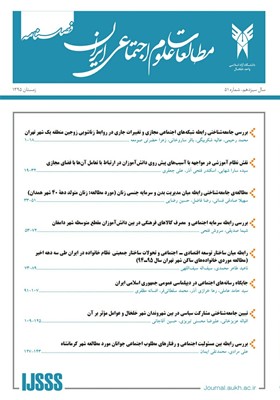ارایه مدل تأثیر عوامل اجتماعی - اقتصادی و فرهنگی بر گرایش دانشجویان به ورزش همگانی (مطالعه موردی: دانشجویان دانشگاه پیام نور استان کرمانشاه )
محورهای موضوعی : خانواده
1 - عضو هیأت علمی دانشگاه پیام نور، گروه تربیت بدنی، تهران، ایران
کلید واژه: ", ورزش همگانی ", , ", سرمایه اجتماعی ورزش محور", , ", سرمایه اقتصادی ورزش محور", , ", سرمایه فرهنگی ورزش محور ", ,
چکیده مقاله :
هدف از پژوهش ، تحلیل تاثیر عوامل اجتماعی -اقتصادی و فرهنگی بر گرایش دانشجویان به ورزش همگانی است. پژوهش توصیفی - همبستگی می باشد. جامعه آماری شامل کلیه دانشجویان دانشگاه پیام نور (5000 نفر) می باشد که با استفاده از جدول کوکران 357 نفر به عنوان نمونه انتخاب شدند. ابزار پژوهش استفاده از تلفیق نظریات گافمن،گیدنز، بوردیو و بلوخ است که مفهوم جدیدی را به نام سبک زندگی ورزش محور طراحی کرده اند. برای تحلیل داده ها از مدل معادلات ساختاری با نرم افزار pls استفاده شده است. نتایج نشان می دهد که متغیرهای جمعیت شناختی با ضریب مسیر 14/0 و مقدار T 06/4، متغیر نمایشی از جنبه های فردی با ضریب مسیر 17/0 و مقدار T 83/4، متغیر قضاوت دیگران از مدیریت فرد بر بدن با ضریب مسیر 39/0 و مقدار T 83/10، متغیر نقش رسانه های ارتباطی با ضریب مسیر 13/0 و مقدار T 13/3، متغیر سرمایه اجتماعی، اقتصادی و فرهنگی با ضریب مسیر 11/0 و مقدار T 24/3و متغیر طبقه اجتماعی-اقتصادی با ضریب مسیر 15/0 و مقدار T 33/3 بر گرایش دانشجویان به ورزش همگانی تاثیر داشته است .. در این میان تاثیر قضاوت دیگران از مدیریت فرد بر بدن دارای بیشترین تاثیر و متغیر سرمایه اجتماعی، اقتصادی و فرهنگی کمترین تاثیر را بر گرایش به ورزش همگانی داشته است.
The objective of study was to analyze the effect of socio-economic and cultural factors on students' tendency to public sport. This is a descriptive-correlational research. The statistical population consisted of all students of Payam-e Noor University of Kermanshah (n=5000), which 357 of them were selected as sample of study using the Cochran sampling. The research tool included the combination of views of Gaffman, Giddens, Bourdieu, and Bloch, developed a new concept called sport-oriented life style. Structural equation model with PLS software was used to analyze the data. The results show that the demographic variables with path coefficient of 0.14 and the T value of 4.06, the representative variable of individual aspects with path coefficient of 0.17 and the T value of 4.83, the variable of others’ judgment of individual management of his body with path coefficient of 0.39 and the T value of 10.83, the role of communication media with the path coefficient of 0.13 and the T value of 3.13, the variable of social, economic, and cultural capital with path coefficient of 0.11, and the T value of 3.24, and the variable of socio-economic status with path coefficient of 0.15 and T value of 3.33 affected the students' tendency to public sport.In this regard, the impact of the judgment of others on individual management on the body had the greatest impact and the variables of social, economic, and cultural capital had the lowest impact on the students’ tendency to public sports.
_||_

